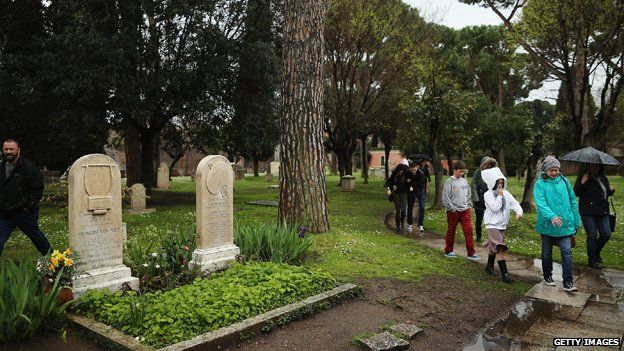Rome's international community of the dead
- Published

Rome is building up to the canonisation of not one but two Popes - the Polish Pope, John Paul ll, and John XXlll. But there is, though, one corner of Rome that always lies just a little beyond the world of Catholicism.
In the winter of 1821, in the heart of Rome, in a house by the Spanish Steps, a young Englishman lay dying.
He was the poet, John Keats. He had tuberculosis, and with death approaching he asked a friend to go and inspect the Protestant Cemetery, where he would be buried.
His companion was able to report back that it would be a fine place for the poet's bones to lie, and all these years on, it remains a rather beautiful setting.
As soon as you step through its gates, the clamour of the city traffic starts to fade. And as you walk further in, the air fills with sound of birds, and the scent of flowers. The sun slants through the tall trees and falls on the ranks of headstones.
They rise up a slope towards a wall that's nearly 2,000 years old - a wall that was once part of the defences of ancient Rome.
This place is now known as the Non-Catholic Cemetery. And when I visited early on a fine, spring morning it seemed to be sunk in a deep peace.
I took the path that leads to a far corner, and to Keats's grave.
On the grass around it there was a bright carpet of white daisies. But the words on the gravestone captured the gloom and sense of failure that engulfed the poet in his last days.
He was only 25, and the world was yet to recognise his genius. He felt he'd made no mark.
The epitaph he asked for on his headstone reads: "Here lies one whose name was writ in water."
Keats's friend and fellow poet, Shelley, called the cemetery the most beautiful he'd ever seen. And soon he'd lie there too.
Just a year after Keats's death, Shelley drowned off the coast of Italy. And his ashes are buried just beneath the Roman wall.
Above the tomb a ruined watchtower rises towards the blue of the sky. Perhaps up on the broken ramparts the ghosts of legionnaires still stand guard.
And in the earth all around Keats and Shelley, in the thousands of graves lie other poets, and painters, and writers and sculptors.
Along with them are diplomats, soldiers, tourists, and many others.
For centuries, Rome with all its history, its past glories and ancient faith has drawn all kinds of people from every corner of the world. Of course, not all of them were Catholic. And at one time, if they died here, that could be a little awkward.
They couldn't be buried in consecrated Catholic ground. But nearly 300 years ago Pope Clement Xl decreed the establishment of the Protestant cemetery - lying just within the sacred city's walls.
Some of the first to be buried there were English visitors struck down in Rome while on the "grand tour" of the sights of Europe.
Others in the cemetery had come hoping Rome's Mediterranean climate might be good for their health - but then been fatally disappointed. Malaria and cholera sometimes lay in wait on the banks of the Tiber.
And some met death in Rome in violent ways. Among those in the graveyard is an early victim of the city's traffic - a traveller who died as he tried to fling himself clear of an overturning, horse-drawn carriage.
There were victims of hunting accidents. And an assassinated Iranian dissident also lies buried beneath the cypress trees.
Some in the cemetery will have felt very far from home as they drew their last breath. But many will have chosen to die here.
They'll have loved Rome, adopted it as theirs and lived long and happy lives in this place.
Now all these people lie together. Americans and Swedes, Russians and Irish, Serbs and Japanese - Protestants, Orthodox Christians, Jews, Muslims and atheists. A great international community of the dead.
And in this mix of peoples and traditions, you see a range of ways that they've tried to mark and make sense of death.
Some do it very simply, with just a few lines on a headstone.
One captures the feelings of a mourning relative with the words: "I shall remember while the light lasts. And in the darkness I shall not forget."
But some have tried to express their emotions in much more elaborate ways.
Standing on one headstone is a sculpture of an almost-naked angel - as tall as a man and with stone wings rising high above his head.
He looks as if he's just landed, and he stares across the graveyard, watching the butterflies flicker through the shadows and between the tombs.
How to listen to From Our Own Correspondent:
BBC Radio 4: Saturdays at 11:30 and some Thursdays at 11:00
BBC World Service: Short editions Monday-Friday - see World Service programme schedule.
Follow @BBCNewsMagazine on Twitter and on Facebook